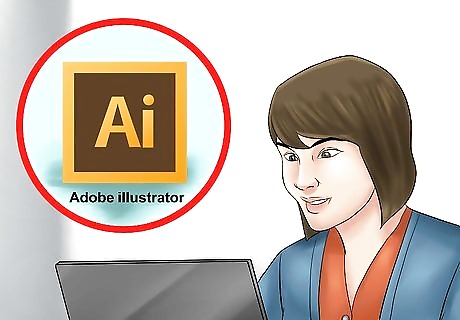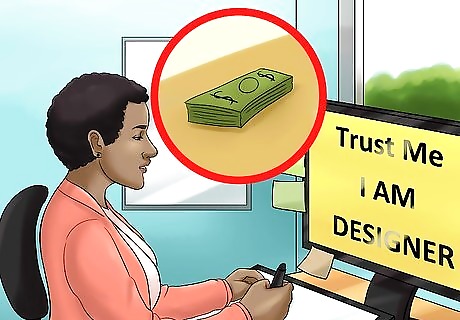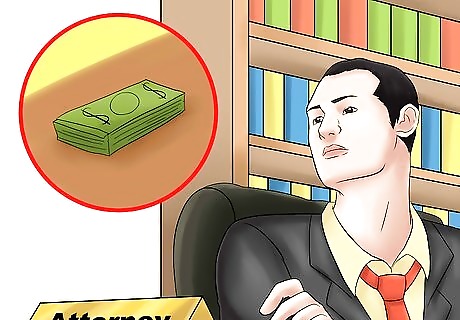
views
X
Research source
A successful symbol is visually striking and easy to recognize, like the skull and crossbones symbol, which represents something poisonous. You do not need a high level of artistic skill to produce an effective symbol. Symbols can be produced in various ways and may even include text, which is also known as a logo. After you create your symbol or logo, you may even want to trademark it to use it for your business.
Developing an Image for Your Symbol

Think about what you want to symbolize. Think about the objects or images that carry meaning for you. Make a list of all of these objects and images. If you are designing a symbol for your product, then try to think about what images best represent your product. Keep in mind that your symbol does not need to be a literal representation of your product, but it should have a strong connection with your brand. For example, having a shoe as your symbol might be too literal if your product is shoes. Instead, you might represent what the shoes allow wearers to do with your symbol, such as run faster or enjoy the outdoors more. If you are designing a personal symbol, then focus on images or objects that might represent important aspects of your personality, heritage, or the message that you want to send. For example, if you are Irish you might incorporate the shamrock or some elements of Celtic design into your symbol.

Sketch two or three of these objects. Gather some materials for sketching such as paper, pens or pencils, and draw a rough sketch of each of the images or objects you listed. The sketches don't have to be perfect, but remember you want your symbol to send a clear message to people who see it. As you sketch, try to keep your goals for the symbol in mind. What message do you want to send?

Pick the image that works best for your product. After you finish your sketches, look over them and think about which one is the most effective. If you are creating a symbol for your business, then the image should be something that is eye catching and easy to recognize. Try to pick the image that you feel has the strongest impact. Try showing your sketches to different people and see which one they prefer. Make sure to ask them why they prefer this image as well. You can use the input to adjust your symbol if needed.

Keep it simple. Simplicity is key in creating an effective symbol. Try not to over design your symbol with lots of embellishments and details. Remove any unnecessary detail or anything visually distracting. Once you have identified any unnecessary or distracting elements, you can either erase them or start over. Some examples of simple yet effective symbols include the Nike swoosh, the Olympic rings, and the Microsoft windows.

Pay attention to color. The color of your symbol can also have a strong effect on the way that people perceive the symbol. Familiarizing yourself with basic color theory can help you to come up with a harmonious and visually arresting symbol. If you are using multiple colors in your symbol design, then make sure that they complement one another. For example, you might chose two polar opposites such as black and white, or two shades of one color, such as light blue and dark blue. Other colors can be jarring if placed beside each other, such as orange and pink. Experts in the psychology of color argue that we have emotional responses to certain colors. Consider this when choosing colors for your symbol. For example, red can signify energy, power, passion, anger, and blood.

Evaluate your final symbol. When you have finished creating your symbol, take a closer look at it and try to determine if there is anything else that might improve it. Some questions you might ask yourself include: Is it simple and appealing? Does it communicate your message well? Do the colors work? Is there anything (big or small) that you’d like to change about it?
Creating a Logo with Letters

Think about what you want your logo to represent. Logotypes are the stylized and graphic illustration of a name or a group of letters. Logos differ from abstract symbols because logos include text. Logos are usually associated with brands or products, but some people have personal logos as well. You might want to create a logo for your business or just for your name or initials. Before you get started, think about why you are creating a logo. For example, do you want to include a logo on your job application materials or personal website to help you stand out? Or will this logo appear on your products? You should also consider who will be viewing your logo and for what purpose. What might appeal to this audience? For example, will the intended audience respond better to some modern-looking or something more traditional?

Choose the letters that you want to have in your logo. Your logo can be a full or partial part of your business name or personal name. If you are creating a logo for your business, then you may want to have the full business name in the logo or just abbreviate it. If you are creating a personal logo, then you may want to use your full name or just your initials. If you decide to use an abbreviation, then you may need to add a symbol or a design element to make sure that your audience knows that the symbol represents you or your business.

Choose a striking font. Some fonts can evoke powerful emotions and feelings, while others may appear bland and emotionless. The font that you choose is central to your logo so make sure that you choose one that is striking but also easy to read. Try checking the fonts that are available in your word processing software or check out online databases of fonts for ideas and inspiration. If you decide to use more than one font, try to keep the number of different fonts to a minimum. Experts recommend using just one or two.

Use a specific design program or an online application. There are many design programs available that can help you to perfect your logo. You can use a design program to produce your logo as a jpeg, tif or png file which can be easily circulated and added to different kinds of documents. Adobe Illustrator is one of the most popular graphic design software programs. You are usually required to pay for these programs, but it might be a worthwhile investment if you need a high-quality logo or if you are planning to produce multiple logos.

Get creative. In order to make your letters into a recognizable, original and striking logo you will have to use your imagination and think creatively. As with symbols, color is important. For example, if you are designing a logo for an all-natural face cream, then you might choose earth-tones to communicate to your audience that the product is natural and free of artificial ingredients. In contrast, bright neon colors might send your audience the message that the product is more artificial or high-tech. Try joining the letters together in an aesthetically pleasing way. For example, you can use shared strokes to link the letters together.

Evaluate your logo for readability and clarity. Clarity is important when you are designing a logo. Make sure that the logo still looks the same when it is re-sized. It should be easy to read and look good no matter what size it is. Remember your logo may be printed on different sized materials, like on a small business card. Make sure that the image is still recognizable if it is inverted as well. If you are using the logo for printed materials then print out the logo and look at it as it would appear on paper. This might help you to identify flaws easier than when you look at it on your computer screen.

Hire a professional graphic designer. If you are struggling to design an effective logo, consider hiring a professional designer. The top firms charge thousands of dollars for logo design but there may be a freelance designer in your area that will charge less. Try to find a designer who specializes in creating logos for your particular purpose. He or she may have some great ideas about what will work best for your needs.
Registering Your Symbol or Logo

Consider hiring an attorney. Trademarking a symbol or logo for your business is a complex process and there are several things that can go wrong. Consulting an attorney who specializes in trademark law is the best way to protect yourself and your business from problems later on. Keep in mind that trademarks, copyrights, and patents protect different types of intellectual property. Trademarks are used to protect symbols, logos, and designs that distinguish your company’s products from your competitors.

Complete a search for similar trademarks. Before you decide to trademark your symbol or logo, it is important to conduct a search for similar trademarks. Otherwise, you run the risk of trademarking a symbol or logo that is identical or similar to a competitor’s symbol or logo. You can search for similar trademarks at: http://www.uspto.gov/trademarks-application-process/search-trademark-database

Look for potential logo and symbol similarities. As you search the database for similar logos and symbols, you should consider the similarities between your logo and/or symbol and those of your competitors. Some things that may affect whether or not your trademark will be accepted include: Sound. Even if your logo is spelled differently than your competitor’s logo, the way the words in the logo sound can be grounds for rejecting a trademark application. For example, if your competitor’s product is called “J. Time,” you could not call your product “Jay Thyme.” These both sound the same when you say them. Appearance. Trademarks also cannot look the same. Therefore, you could not use “J. Time” as your logo with a different font. For a symbol, you could not use an image that looks similar to one of your competitors. Meaning. Logos cannot share meaning either. For example, you could not have a brand logo called “Fortunate” if your competitor’s logo bore the name “Lucky.” These words mean almost the same thing. Commercial Impression. You also cannot use a symbol or logo that might lead to confusion for your customers. For example, you could not use the same symbol as a competitor and just leave out the words in the logo. The image would confuse customers about whether or not the product was made by your competitor.

Fill out a trademark application. Once you are certain that your product’s logo and/or symbol does not infringe on any of your competitors’ logos or symbols, then you can complete an application to register your trademark. You can file your application online by visiting: http://www.uspto.gov/trademarks-application-process/filing-online

Pay the filing fee. The cost of filing for a trademark is somewhat high. It ranges between $225 and $325, depending on the type of form you fill out. The three different types of forms include the TEAS plus form, TEAS reduced fee form, and the TEAS regular form. For the plus form and the reduced fee form, you will need to authorize email communication. You have to complete a full application for the plus form, which offers the lowest filing fee ($225). The TEAS regular form is ideal for those who do not want to complete the full application right away and do not want to receive correspondence via email.













Comments
0 comment